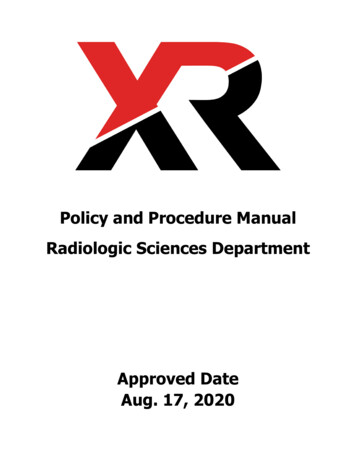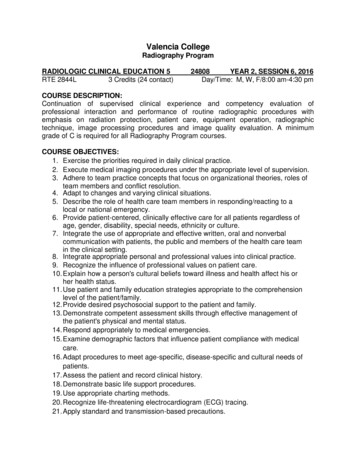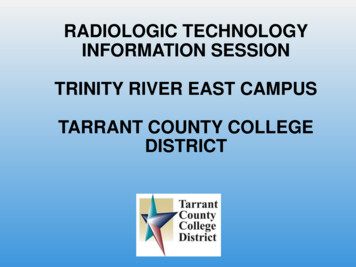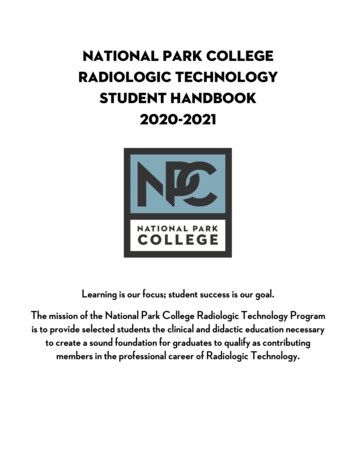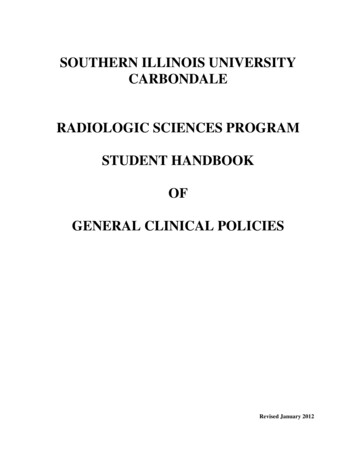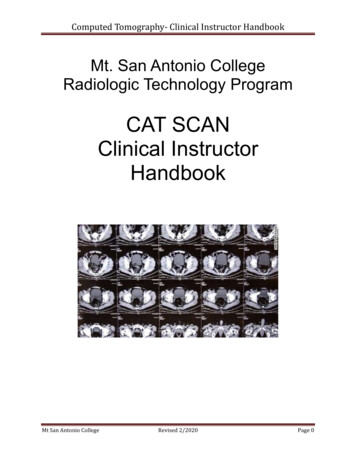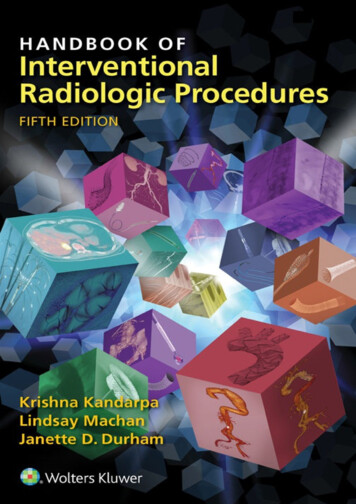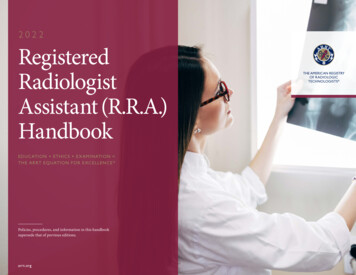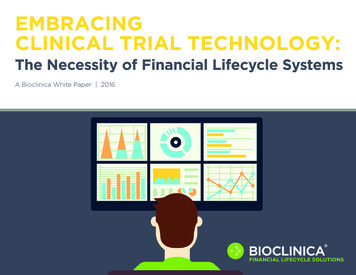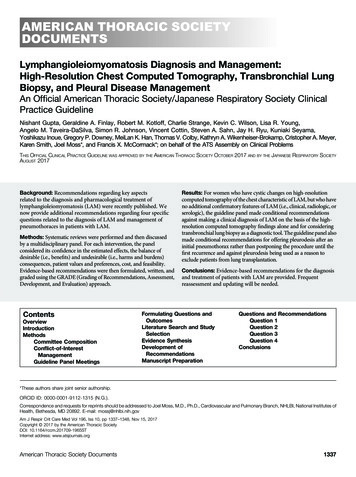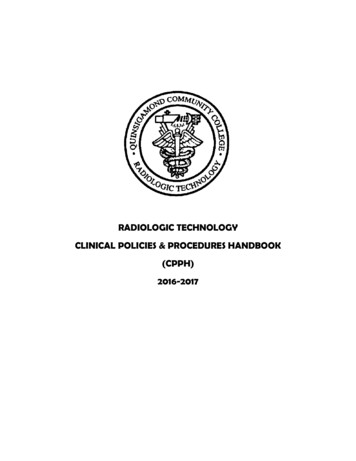
Transcription
RADIOLOGIC TECHNOLOGYCLINICAL POLICIES & PROCEDURES HANDBOOK(CPPH)2016-2017
TABLE OF CONTENTSGENERAL INFORMATION--3Mission Statement & Program Goals-----3Curriculum------4------5Clinical Schedule Overview ------6General Clinical Objectives ------6Clinical SyllabiRDT 131RDT 132RDT 231RDT 232------891011Required Competency Exams-----12Competency Education Plan ------13Introduction-Clinical Education Settings--POLICIESIntroductionQCC RT Program------151. Clinical RequirementsCPR CertificationCORI/SORI ReviewRandom Drug ScreeningFingerprint IdentificationTechnical StandardsTrajecsys -----152. CES Assignment------163. Attendance------164. Confidential Information------175. Professionalism------186. Counseling/Discipline------187. Daily Log Record. -------198. Clinical Equity, Assessment & ProgressPerformance EvaluationCompetency Evaluation----209. Personal Appearance-----2210. Health & Safety PregnancyLatex Sensitivity/AllergyStandard PrecautionsInfection ControlMRI SafetyWorkplaceImpaired Behavior-----2211. Clinical Leave ------2512. Radiation Safety & Monitoring-----2513. Student Supervision-----26----1June 2016
14. Communication -------2715. Harassment------2716. Clinical/School Cancellation-----2717. Student Records------2818. Re-admission------2819. Honors & Awards------2920. Grievance------29--FORMSDaily Log Form------32Performance Evaluation FormsFirst SemesterSecond-Fourth Semesters-----3335Simulation -60-Check-off Evaluation FormsPatient CareImage Processing/CRVital Signs & O2 AdministrationPatient Transfer Radiographic EquipmentFluoroscopic EquipmentMobile & C-arm EquipmentSterile Procedure & Emergency EquipmentCT RotationFinal Competency Evaluation atric Competency Failure/Remedial ProcessCommunication for Resolution-----61Counseling Report-----62Latex Sensitivity/Allergy Disclosure-----63Policy & Procedure Agreement----64Declaration of Pregnancy-----65Request for Added Clinical Experience -----66MRI Screening Form (sample)-----67Clinical Calendars ------68---AppendixNational & State Professional AgenciesAssessment PlanPolicy Review TimelineARRT Standards of EthicsASRT Practice StandardsJRCERT Accreditation StandardsQCC RT Program2June 2016
QUINSIGAMOND COMMUNITY COLLEGE RADIOLOGIC TECHNOLOGY PROGRAMIntroduction:This document contains all information pertaining to the clinical education aspect of the Radiologic Technology program.The policies and procedures are specific and detailed so that the student is fully informed as to the expectations for theiractions and progress while in the clinical setting. Students will be providing care to actual patients, using sophisticatedequipment producing ionizing radiation. It is of paramount importance that students understand their responsibilities totheir patient, profession and education. Students will receive additional information on policies and procedures at theirrespective clinical sites. The agreements held between the college and each clinical education setting (CES) allows for theremoval of any student from the clinical education setting for just cause as deemed by the CES administration. Studentsare expected to be fully informed as to the contents of this document and to consult it as needed. Additionally, eachstudent must sign and submit to the Program Director the Statement of Compliance provided during the Orientationprocess (and included at the end of the Forms section) before the start of clinical assignments. Any questions or furtherclarification of this document may be addressed with the program faculty:Linda LeFave, M.Ed., RT(R)(M)(QM)Program Directorlindal@qcc.mass.edu508-854-4289Colleen Kirley, B.S., RT(R)(CT)Clinical t Gniadek, B.S., RT(R)(M)Clinical n Statement:The QCC Radiologic Technology program educates individuals, who upon completion of the program demonstrate entry level skills,knowledge and professional attributes essential to the practice of Radiologic Technology. Students meet the professionalresponsibilities of caring for patients from a global society, through the integration of personal and professional values, theoreticalknowledge and clinical skills.Program Goals*The Radiologic Technology program prepares students to serve the local community as medical imaging professionals bymeeting the specific goals to: (1) demonstrate competence in performing entry-level medical radiography procedures, (2)exhibit professional and ethical behaviors, (3) demonstrate critical thinking & problem solving skills for immediate and lifelong learning, and (4) employ effective written and oral communication skills.*Full Assessment Plan with Learning Outcomes & Measures included in AppendixQCC RT Program3June 2016
RADIOLOGIC TECHNOLOGY PROGRAM CURRICULUMCourse NumberCourse TitleCreditsFirst YearSummer SessionENG 101BIO 111MAT 122English Composition & Literature IAnatomy & Physiology IStatistics34310 totalFall SemesterPSY 101PSY 118SPH 101RDT 102RDT 104RDT 110RDT 121RDT 131Introduction to Psychology ORPsychology of Interpersonal RelationsSpeech Communication SkillsPatient Care & Ethics in RadiologyRadiographic Medical TerminologyFundamentals of Radiographic Equipment &Medical ImagingRadiographic Positioning & Anatomy IMedical Radiographic Clinic I333133218 totalSecond SemesterBIO 112RDT 112RDT 122RDT 132RDT 141Anatomy & Physiology IIMedical Imaging IIRadiographic Positioning & Anatomy IIMedical Radiographic Clinic IIRadiation Science4335217 totalSecond YearFirst SemesterENG 102RDT 231RDT 240RDT 245English Composition & Literature IIMedical Radiographic Clinic IIIImaging ApplicationsMedical Radiographic Equipment & Quality Assurance354315 totalMedical Radiographic Clinic IVRadiology SeminarRadiographic Pathology and PharmacologyCT & Cross Section Anatomy443213 totalSecond SemesterRDT 232RDT 252RDT 254RDT 260Total credits required for degreeQCC RT Program473June 2016
QUINSIGAMOND COMMUNITY COLLEGERADIOLOGIC TECHNOLOGY PROGRAMCLINICAL EDUCATION SETTINGS & INSTRUCTORSSt. Vincent Hospital123 Summer StreetWorcester, MA 01604(508) 363-6370Joan Shea, B.S., ssMemorial Medical CenterMemorial Campus119 Belmont StreetWorcester, MA 01605(508) 334-5794Michele Foley, A.S., R.T.(R)(ARRT)Michele.Foley@umassmemorial.orgHealth Alliance HospitalLeominster Campus60 Hospital RoadLeominster, MA 01420(978) 466-2685Bethann Fatcheric, A.S., R.T. y Campus55 North Lake AvenueWorcester, MA 01655(774) 442-5147Jessica Helliwell, A.S., R.T.(R)(ARRT)jhelliwell@qcc.mass.eduKayte Foley, B.S., R.T.(R)(ARRT)kfoley1@healthalliance.comJonathan Umana, A.S., R.T.(R)(ARRT)jumana@qcc.mass.eduHeywood Hospital242 Green StreetGardner, MA. 01440(978) 630-6530Amanda Ares, B.A., R.T.(R)(ARRT)Amanda.ares@heywood.orgMarlborough Hospital157 Union StreetMarlborough, MA 01752(508) 486-5615Matthew Carey, A.S., gton Hospital100 South StreetSouthbridge, MA 01550(508) 765-3043Jessica Forcier, A.S., t Medical Group135 Gold Star BoulevardWorcester, MA 01606(508) 853-0011 x56223Lisa Kisiel, A.S., sa Maniatis, B.S., R.T.(R)(ARRT)lmaniatis@qcc.mass.eduQCC RT Program5June 2016
MEDICAL RADIOGRAPHIC CLINIC SCHEDULERDT 131 is scheduled on Tuesdays & Thursdays. The hours will be 12:30 – 4 pm for Thursdays during the first five weeks and thenwill be for an 8.5 hr shift. Tuesdays will be the 8.5 hr shift for the full semester. Each clinical education setting determines thespecific hours for the full-day shift (i.e. 7:00-3:30; 7:30-4:00; 8:00-4:30).RDT 132* begins the first weekday following January 1st, Monday - Friday (40 hrs. per week) for the duration of the college winterintersession, then resumes the Tuesday/Thursday schedule when second semester classes begin. Clinical hours will be a full 8.5hour day shift. At the conclusion of the semester, the clinical assignment will increase to full time (32-40 hrs. per week) through theend of June.RDT 231* begins the first week of August (may include the last days of July) and occurs at a new clinical education setting (studentsnotified of their assignment during May). During this period clinical will be scheduled on a full time basis (40 hrs. per week) until thefall semester begins (approximately Sep.1), at which time the scheduled days will be Monday, Wednesday and Friday.RDT 232* begins the week before the start of the spring semester on a full time basis (40 hrs. per week) and follows theMonday/Wednesday/Friday schedule when the regular semester starts.* Each student may be assigned to work an alternate (i.e. 11 a.m.-7 p.m.) shift and rotate to alternate clinical sites for approximately 2week periods to further enhance learning experiences for procedures related to trauma, surgery, and pediatrics.General Objectives for Clinical AssignmentsThe clinical experiences are the most important and meaningful activities in which the students will participate. During the two yearsof the program, each student will be assigned to two different Clinical Education Settings (CES) and will be assigned to differentdiagnostic areas within each of them. The specific criteria for successful completion of the clinical courses are detailed in the policysection of this manual; overall objectives for the clinical courses are:1. To acquire expertise and proficiency in a wide variety of diagnostic radiographic procedures by applying classroom theory to thepractice of technical skills with patients, at specified levels of competency.2. To develop and practice professional work habits and appropriate interpersonal relationships with patients and other members ofthe healthcare team, as set forth by the ASRT Scope of Practice and the ARRT Code of Ethics.In addition to information contained in the syllabi for each clinical course, the student is expected to meet the following objectivesduring their clinical education experiences. It is expected that each student will seek out the information required to successfullysatisfy and achieve these objectives.Section I: Patient CareThe student:1. Assesses a patient's clinical history and determines the appropriate radiographic procedure.2. Maintains patient privacy, confidentiality, and respect.3. Defines and correctly uses common medical terminology and abbreviations.4. Differentiates between safe and unsafe patient scenarios.5. Offers acceptable alternative exam procedures for patients with limitations.6. Recognizes and applies the skills needed to assess a patient's physical condition, including pregnancy status.7. Recognizes and applies alternative methods for positioning trauma patients.8. Describes the appropriate treatment of patients with bandages, splints, cervical collars, joint immobilizers, traction devices, etc.,as they pertain to performing radiographic exams.QCC RT Program6June 2016
9. Assists with the preparation of contrast media and demonstrates proper sterile technique.10. Utilizes and applies the basic premise of standard precautions.11. Demonstrates appropriate radiation protection practices.Section II: Radiographic ProceduresThe student:1. Recognizes and performs radiographic procedures for the following exams:a. chestg. lumbar spineb. abdomenh. cervical spinec. upper extremity (finger to clavicle)i. bony thoraxd. lower extremity (toe to femur)j. upper GI seriese. pelvis, hipsk. barium enemaf. thoracic spinel. craniofacial exams2. Utilizes the correct image receptor system to be used for each of the above stated exams, including the correct sizecassette/orientation.3. Properly performs the above exams in terms of positioning, exposure factors, SID, and body orientation.4. Identifies appropriate sets of exposure factors to obtain diagnostic quality images.5. Assesses the quality of radiographic images by applying the principles and knowledge of a radiographic critique process.Section III: Radiographic EquipmentSpecific to the radiology department currently assigned to, the student:1. Identifies the manufacturer of the radiographic and fluoroscopic equipment.2. Identifies the manufacturer of the image receptor and processing system used.3. Operates radiographic equipment efficiently and safely.4. Describes the contents, use, and location of the emergency cart.5. Identifies radiographic rooms (by number), which are equipped with equipment such as an upright bucky, panelipse unit,tomographic unit, and fluoroscopic unit.Section IV: Departmental AdministrationSpecific to the radiology department currently assigned to, the student:1. Identifies the department administration hierarchy.2. Utilizes the correct protocol for the completion of exams, i.e. what instructions the patient needs; ensuring images reach theappropriate destination, tracking radiographic procedures in RIS (Radiology Information System), etc.3. Identifies the correct code to indicate various patient and hospital emergency situations.Section V: Clinical PolicesIn reference to the program’s Clinical Policies & Procedures handbook, the student will:1. Describe the correct procedure for calling in late or absent (policy 3).2. Identify those behaviors/actions that will prohibit continuation in this program (policy 6).3. Explain the sequence of learning activities in preparation for demonstrating competency (policy 8).4. State the process to follow upon failing a competency examination (policy 8.7).5. State and practices proper radiation protection and dosimetry methods (policy 12).6. Identify the correct procedural steps required for repeating a radiographic exam (policy 13).7. Differentiate between “direct” & “indirect” supervision; explain these terms relative to their competency status (policy 13).QCC RT Program7June 2016
RDT 131Medical Radiography – Clinic IPlacement:Instructor:Time Span:Co-Requisites:First Year: First SemesterClinical Instructor of Assigned CES/Clinical CoordinatorSeptember – DecemberRDT 110 & RDT 121S.H. Credit: 2Course Description:This course focuses on developing basic skills for the practice of radiography. Students learn proper methods to radiograph and carefor patients with emphasis on equipment manipulation, patient care, image processing procedures, chest, abdomen, and extremityradiography. Students develop these skills at a clinical site under direct supervision. They advance from observation, to assisting withprocedures, and then performing the exam with direct supervision. Students assess radiographic images for quality, accuracy, andsuggest options for improvement. Students focus on performing radiographic exams of the chest, abdomen, upper and lowerextremities.Course Outcomes:1. Explain and perform the routine procedures and daily tasks expected in the assigned Clinical Education Setting.2. Understand/perform the basic principles involved in equipment manipulation, image processing, and patient care.3. Begin to understand and demonstrate the criteria necessary to critique a radiographic image.4. Complete check-off procedures and simulations necessary for category competency evaluations.5. Perform clinical competencies.6. Demonstrate technical and professional development.Clinical Skill & Course Requirements:1. Satisfactory completion of pre-clinical evaluations in Equipment, Patient Care, Image Processing, Patient Transfer, VitalSigns & O2 Administration. The first 4 pre-clinical (check-off) evaluations must be satisfactorily completed before attemptingcompetency evaluation.2. Observe and assist with routine radiographic procedures of the chest, abdomen, upper & lower extremities.3. Successful completion of 3 competencies from procedures associated with RDT 121 are required to earn a passing gradefor this course. Additional competencies may be completed towards the requirements for RDT 132.4. Compliance with hospital & college policy/procedures regarding professional and ethical conduct.5. Successful completion of exam simulations associated with RDT 121.Attendance Policy:A clinical calendar will be issued for the entire first year of the program. Adherence to the program’s attendance policy (3) is required.Grading Policy:Evaluation of the student’s progress will be assessed by an average of scores obtained in the various areas of clinical skills and afinal exam. The clinical skills grade will be derived from the following: a) performance evaluations; b) check-off procedures (asindicated above); c) exam simulations and competency evaluations; and d) final exam with a passing grade of 73% or better.Grade Computation:Competencies35%Performance Evaluations 40%Final Exam25%Rotation AssignmentsRadiographic roomsOrthopedicsEmergency roomsAAB BLetter Grade Assignment*95-100B90-94C 87-89C83-86F80-8277-7973-760-72A minimum grade average of 73% AND the completion of 3 competencies are required to pass this course.*Course averages are rounded to the decimal value; i.e. 72.5 final average of 73; 72.4 final average of 72QCC RT Program8June 2016
RDT 132Medical Radiography – Clinic IIPlacement:Instructor:Time Span:Prerequisite:First year: Second SemesterClinical Instructor of Assigned CES/Clinical CoordinatorJanuary through JuneRDT 131S.H. credit: 5Course Description:This course expands students’ clinical skills through their participation in more varied and complex radiographic procedures withemphasis on imaging the upper/lower extremities, pelvis, spinal column, bony thorax and GI systems. Students gradually advance toperform these procedures on more acute patients and under atypical conditions. Students continue to develop their ability to critiqueimages of procedures learned during the previous and current semesters. This course extends beyond the spring semester to includethe month of June (32-40 hours/week). During this period, students focus on improving their skills, as well as performing fluoroscopyexams of the GI system. An introduction to mobile and surgical radiography procedures is also done during this time.Course Outcomes:1. Develop expertise in administering to patients’ needs and concerns during more complex and independent procedures.2. Continued development towards effectively critiquing the radiographic image.3. Perform clinical competencies for radiographic procedures to include the upper and lower extremities, pelvis and hips,abdomen, chest, thoracic, and lumbar spines.4. Expand development of clinical organizational skills and adaptability through completion of alternative shift assignments.Course Completion Requirements:1. Completion of Fluoroscopic Equipment, Sterile Procedures & Emergency Equipment and Mobile Equipment* pre-clinical(check-off) evaluations.2. Successful completion of 20** mandatory or elective competencies from procedures associated with RDT 121 & 122 arerequired to earn a passing grade for this course. Midterm requirements: at least (10) mandatory or elective competencyexams MUST be completed.3. Compliance with hospital and college policy/procedures regarding professional and ethical conduct.4. Demonstrate continued progress in technical and professional development5. Successful completion of exam simulations associated with RDT 122.*At the discretion of the clinical instructor at a specific CES**An additional 6 competencies may be completed & carried over to RDT 231.Attendance Policy:Clinical days are assigned as indicated on the clinical calendar and adherence to the policy 3 is required. Any variation must becleared with the clinical instructor.Grading Policy:Evaluation of the student’s progress will be assessed by an average of scores obtained in the various areas of clinical skills and afinal exam. The clinical skills grade will be derived from the following: a) performance evaluations b) check-off procedures (asindicated above); c) exam simulations and competency evaluations; and d) final exam with a passing grade of 73% or better.Grade Computation:CompetenciesPerformance EvaluationsFinal Exam35%40%25%Rotation AssignmentsRadiographic roomsFluoro roomsEmergency roomsMobile ProceduresAAB BLetter Grade Assignment*95-100B80-8290-94C 77-7987-89C73-7683-86F0-72A minimum grade average of 73% AND the completion of 20 competencies are required to pass this course.*Course averages are rounded to the decimal value; i.e. 72.5 final average of 73; 72.4 final average of 72QCC RT Program9June 2016
RDT 231Medical Radiography – Clinic IIIPlacement:Instructor:Time Span:Prerequisites:Second Year; Summer Intersession & Fall SemesterClinical Instructor of Assigned CES/Clinical CoordinatorAugust through DecemberRDT 132SH Credit: 5Description:This course focuses on the development of students’ clinical skills with emphasis on performing fluoroscopy, mobile, and surgicalexams, as well as imaging facial bones, and sinuses. Students expand their skills to imaging trauma procedures; are introduced topediatric imaging; assume independent care of stable and mildly acute patients; and closely assist with more severely acute patients.Students use problem solving and critical thinking skills in the management of non-typical imaging situations and continue to enhanceskills involved in the assessment of image quality.Course Outcomes:1. Adaptation to the department organization and procedures of a new Clinical Education Setting.2. Perform exams more independently.3. Affectively administer to patient needs in typical and atypical situations.4. Perform clinical competencies.5. Demonstrate continued competency in previously evaluated exams.6. Develop and demonstrate necessary skills to perform exams on trauma, pediatric, and surgical patients.Course Completion Requirements:1. Completion of pre-clinical (check-off) evaluations for Mobile Radiographic Equipment and C-Arm Fluoroscopic Equipment.2. Successful completion of 20 mandatory or elective competency exams from procedures associated with RDT 121, 122 and240 are required to earn a passing grade for this course. Midterm requirements: at least (10) mandatory or electivecompetency exams MUST be completed.3. Completion of four additional (4) ongoing competency exams (instructor selected).4. Demonstration of continued progress and competency in technical and professional development.5. Compliance with hospital and college policy/procedures regarding professional and ethical conduct.6. Successful completion of exam simulations associated with RDT 240.Attendance Policy:Clinical days are assigned as indicated on the clinical calendar and adherence to the policy 3 is required. Any variation must becleared with the clinical instructor.Grading Policy:Evaluation of the student’s progress will be assessed by an average of scores obtained in the various areas of clinical skills and afinal exam. The clinical skills grade will be derived from the following: a) performance evaluations (form B); b) check-off procedures(as indicated above); c) exam simulations and competency evaluations; and d) final exam with a passing grade of 73% or better.Grade Computation:CompetenciesPerformance EvaluationsFinal Exam35%40%25%Rotation AssignmentsRadiographic / FluoroscopyER / ORMobile ProceduresPediatricsAAB BLetter Grade Assignment*95-100B80-8290-94C 77-7987-89C73-7683-86F0-72A minimum grade average of 73% AND the completion of 20 initial & 4 ongoing competencies are required topass this course.*Course averages are rounded to the decimal value; i.e. 72.5 final average of 73; 72.4 final average of 72QCC RT Program10June 2016
RDT 232Medical Radiography – Clinic IVPlacement:Instructor:Time Span:Prerequisite:Second Year; Second SemesterClinical Instructor of Assigned CES/Clinical CoordinatorJanuary through MayRDT 231S.H. Credit 4Course Description:This course concentrates on refining students’ skills in performing all mandatory and elective procedures required for graduation andeventual employment as an entry-level radiographer. Students work independently, with indirect supervision, on all exams for whichthey have been evaluated as competent. Advanced imaging procedures are presented and include specialized cranio-facial imaging,basic special procedures, trauma, pediatric, and surgical exams. Students are encouraged to experience advanced modalities suchas CT, MR, angiography, nuclear medicine, mammography, and sonography, providing the required competencies are complete.Course Outcomes:1. Achieve independence in the ability to perform routine radiographic procedures.2. Observe procedures performed in elective modalities, providing basic requirements have been satisfied.3. Perform clinical competencies.4. Demonstrate continued competency in previously evaluated exams.5. Perform radiographic exams and procedures on trauma, pediatric, and atypical patients.6. Demonstrate expertise and independence when critiquing radiographs.Clinical Skills & Course Requirements:1. Completion of Sterile Procedures & Emergency Equipment and Vital Signs/O2 Administration check offs.2. Successful completion of 12 remaining mandatory and elective competency exams are required to earn a passing grade forthis course. Midterm requirements: at least half the remaining mandatory or elective competency exams MUST becompleted.3. Completion of four (4) ongoing competency exams (instructor selected).4. Demonstrate continued competency and progress in professional and technical skills.5. Compliance with all hospital and college policy/procedures regarding ethical and professional conduct.Attendance Policy:Clinical days are assigned as indicated on the clinical calendar and adherence to the policy 3 is required. Any variation must becleared with the clinical instructor.Grading Policy:Evaluation of the student’s progress will be assessed by an average of scores obtained in the various areas of clinical skills and afinal exam. The clinical skills grade will be derived from the following: a) performance evaluations (form B); b) check-off procedures(as indicated above); c) competency evaluations; and d) final exam with a passing grade of 73% or better.Grade Computation:CompetenciesPerformance EvaluationsFinal Exam35%40%25%Rotation AssignmentsRadiographic / FluoroscopyER / ORMobile ProceduresPediatricsModalities (CT, mammo, etc)AAB BLetter Grade Assignment*95-100B90-94C 87-89C83-86F80-8277-7973-760-72A minimum grade average of 73% AND the completion of 12 initial & 4 ongoing competencies are required topass this course.*Course averages are rounded to the decimal value; i.e. 72.5 final average of 73; 72.4 final average of 72QCC RT Program11June 2016
Competency RequirementsExams Appropriate for RDT 131 – 3 requiredMandatory ExamsFinger or ms Appropriate for RDT 132 – 20 requiredMandatoryHumerusKneeLumbar SpineRibsShoulderFemurThoracic spineAbdomen – SupineClavicleHipChest RoutineAbdomen – UprightPelvisChest – AP cyxScapulaAC JointsCalcaneusSI JointsElectivesExams Appropriate for RDT 231 – 20 requiredMandatoryCervical SpineHip (CTL)Mobile ChestGeriatric Patient – ChestTrauma Upper ExtremitySpine (CTL)Mobile AbdomenGeriatric – Upper ExtremityTrauma Lower ExtremityFluoro – Upper GI or BEMobile ExtremityGeriatric – Lower ExtremityTrauma Shoulder (trans, axial/Y)Fluoro (select from electives)ElectivesScoliosis SeriesFluoro – UpperGI or BEFluoro – ERCPFluoro - HSGAbdomen decubitusFluoro – Esophagus StudyFluoro – ArthrographyFluoro – Cysto/cystourethrogramChest, decubitusFluoro – Small bowel SeriesFluoro – MyelographyUpper Airway (Soft-Tissue Neck)Ongoing Competencies (4)Exams Appropriate for RDT 232 – 12 requiredMandatoryHead (select from electives)Pediatric ChestC-Arm Surgical (Sterile field)C-Arm Surgical (Manipulation)Ongoing Competencies (4)ElectivesPediatric AbdomenPediatric Mobile ExamHead – OrbitsHead – MandiblePediatric Upper ExtremityHead – SkullHead – Nasal BonesHead – Zygomatic ArchesPediatric Lower ExtremityHead – SinusesHead – Facial BonesHead – TMJ’sTotal: 40 Mandatory; 15 Electives (of 32); 8 OngoingTrauma indicates shock or injury to the body requiring exam modifications & monitoring of patient conditionGeriatric indicates a patient physically or cognitively impaired as a result of agingPediatric indicates age 6 or youngerOngoing indicates continuing competency on exam previously completed and with increased level of complexity emphasized6 additional comps can be carried from 1st to 2nd rotationQCC RT Program12June 2016
COMPETENCY EDUCATION PLANStep 1: InstructionDidactic material presented by academic or clinical facultyStep 2: PracticePositioning with non-patients at clinic and/or college labPatient Care, Equipment/Image Processing (check-offs)Step 3: Simulate Projections for all ExamsComplete checklist simulation with clinical instructor or program facultyStep 4: Practice Exams (DIRECT SUPERVISION)Record activity on Daily Log formNotify CI when ready to attempt competency evaluationStep 5: Competency EvaluationMinimum score of 85% - first attemptSuccessful Competency – go to step 6Failed Competency – RemediateReview, Simulate, Practice with Direct SupervisionSuccessful competency requires a score of 90% for the second attemptA third (final) attempt is permitted after repeat remediation; must earn a score of 90%Step 6: Ongoing Skill Development (INDIRECT SUPERVISION)Continue to improve exam quality.If repeat is required, must be done with direct supervisionStep 7: Repeat Imaging (DIRECT SUPERVISION)After satisfactory competency has been achieve and student is working with Indirect Supervision; ALLrepeat images must be performed with Direct SupervisionStep 8: Ongoing CompetencyDemonstrate continued proficiency and improved care of patients during morecomplex and independent proceduresQCC RT Program13June 2016
Policies & ProceduresQCC RT Program
The Radiologic Technology program prepares students to serve the local community as medical imaging professionals by meeting the specific goals to: (1) demonstrate competence in performing entry-level medical radiography procedures, (2) . In reference to the program’s Clinical Policies &
